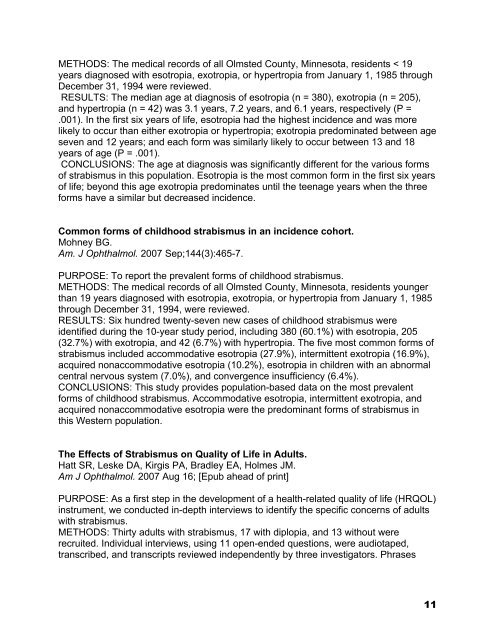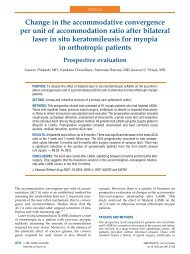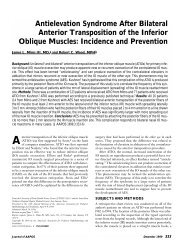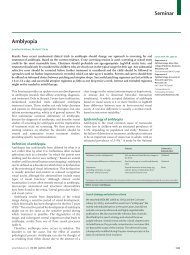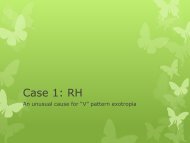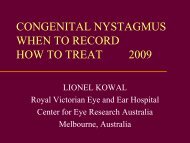What's new AAPOS 2008 - The Private Eye Clinic
What's new AAPOS 2008 - The Private Eye Clinic
What's new AAPOS 2008 - The Private Eye Clinic
You also want an ePaper? Increase the reach of your titles
YUMPU automatically turns print PDFs into web optimized ePapers that Google loves.
METHODS: <strong>The</strong> medical records of all Olmsted County, Minnesota, residents < 19<br />
years diagnosed with esotropia, exotropia, or hypertropia from January 1, 1985 through<br />
December 31, 1994 were reviewed.<br />
RESULTS: <strong>The</strong> median age at diagnosis of esotropia (n = 380), exotropia (n = 205),<br />
and hypertropia (n = 42) was 3.1 years, 7.2 years, and 6.1 years, respectively (P =<br />
.001). In the first six years of life, esotropia had the highest incidence and was more<br />
likely to occur than either exotropia or hypertropia; exotropia predominated between age<br />
seven and 12 years; and each form was similarly likely to occur between 13 and 18<br />
years of age (P = .001).<br />
CONCLUSIONS: <strong>The</strong> age at diagnosis was significantly different for the various forms<br />
of strabismus in this population. Esotropia is the most common form in the first six years<br />
of life; beyond this age exotropia predominates until the teenage years when the three<br />
forms have a similar but decreased incidence.<br />
Common forms of childhood strabismus in an incidence cohort.<br />
Mohney BG.<br />
Am. J Ophthalmol. 2007 Sep;144(3):465-7.<br />
PURPOSE: To report the prevalent forms of childhood strabismus.<br />
METHODS: <strong>The</strong> medical records of all Olmsted County, Minnesota, residents younger<br />
than 19 years diagnosed with esotropia, exotropia, or hypertropia from January 1, 1985<br />
through December 31, 1994, were reviewed.<br />
RESULTS: Six hundred twenty-seven <strong>new</strong> cases of childhood strabismus were<br />
identified during the 10-year study period, including 380 (60.1%) with esotropia, 205<br />
(32.7%) with exotropia, and 42 (6.7%) with hypertropia. <strong>The</strong> five most common forms of<br />
strabismus included accommodative esotropia (27.9%), intermittent exotropia (16.9%),<br />
acquired nonaccommodative esotropia (10.2%), esotropia in children with an abnormal<br />
central nervous system (7.0%), and convergence insufficiency (6.4%).<br />
CONCLUSIONS: This study provides population-based data on the most prevalent<br />
forms of childhood strabismus. Accommodative esotropia, intermittent exotropia, and<br />
acquired nonaccommodative esotropia were the predominant forms of strabismus in<br />
this Western population.<br />
<strong>The</strong> Effects of Strabismus on Quality of Life in Adults.<br />
Hatt SR, Leske DA, Kirgis PA, Bradley EA, Holmes JM.<br />
Am J Ophthalmol. 2007 Aug 16; [Epub ahead of print]<br />
PURPOSE: As a first step in the development of a health-related quality of life (HRQOL)<br />
instrument, we conducted in-depth interviews to identify the specific concerns of adults<br />
with strabismus.<br />
METHODS: Thirty adults with strabismus, 17 with diplopia, and 13 without were<br />
recruited. Individual interviews, using 11 open-ended questions, were audiotaped,<br />
transcribed, and transcripts reviewed independently by three investigators. Phrases<br />
11


